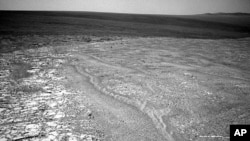The Mars rover, Opportunity, has found the strongest evidence yet that liquid water probably once flowed on the red planet. US space agency scientists say cameras on the remotely-controlled vehicle spotted a bright white vein of calcium sulfate, or gypsum, a mineral that almost certainly was deposited long ago by water flowing through a crack in underground rock.
The mineral vein examined closely by the US space agency NASA’s Mars rover Opportunity is about the width of a human thumb and just under a meter in length.
Steve Squyres of Cornell University in New York is principal investigator for the Opportunity mission. Announcing the discovery at a meeting of the American Geophysical Union in San Francisco, Squyres said one and possibly more calcium sulfate-containing rock fissures were found by Opportunity in bedrock as the rover approached the rim of a large crater called Endeavour.
“And we were driving this one segment of the rim and there were just all these bright, white lines on the ground. I mean it was like somebody had gone out there with a great big fat chalk marker and marked up the rocks. And we went and we looked at these things and in fact they were gypsum-filled veins," said Squyres. "So, it was hard to miss.”
Mission scientists say this is the first time Opportunity has detected a mineral deposit during its 90 month trek to the Endeavour crater, where the gypsum vein was discovered.
Opportunity and its twin rover, Spirit, began their investigation of the Martian surface in April 2004, combing the rocky landscape for evidence of liquid water.
Their missions were only supposed to last for a few months but instead went on for years. Spirit eventually stopped communicating with mission controllers in 2010. But the Opportunity rover is still going strong.
Until now, the twin rovers had sent back only tantalizing signs that water once flowed on Mars. Now, Squyres says, he is certain that water formed the disinctive gypsum vein.
“In the other instances, we found water-form[ed] minerals, but they’ve been blown around by the wind, they’ve been mixed in with other stuff," he said. "It’s kind of hard to figure out exactly what they mean whereas this - boom - it’s right there.”
On Earth, calcium-sulphate or gypsum is used for making drywall or plaster of Paris.
Squyres says it’s getting to be the slow season for Opportunity as the solar-powered rover weathers another Martian winter, which is about twice as long as winters on Earth.
Once longer springtime days return to Mars and the rover can fully recharge its battery, Squyres says mission scientists will use the Microscopic Imager and Alpha Particle X-ray Spectrometer on Opportunity’s arm to more closely examine the mineral composition of the veins.
NASA Rover Finds New Evidence Water Once Flowed on Mars














